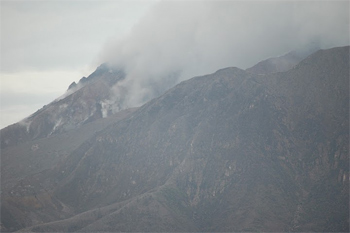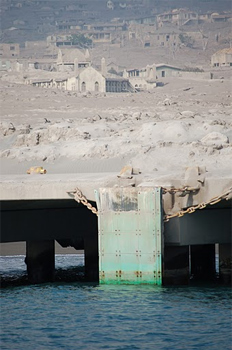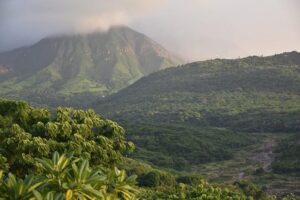
By Mark Rice
What does it mean to experience a volcano?
The question kept running through my head on the short flight from Antigua to Montserrat, as I sat squeezed into an airplane so small that I could tap the pilot on her shoulder to ask her a question about an island off to our right.
I was getting ready to experience my third volcano, the first since deciding that volcanoes were part of my destiny.
Let me back up.
I turned fifteen in 1980, the year that Mount St. Helens erupted. My hometown sat right on the edge of the volcano’s ash plume, a clear morning sky visible to the south, inky black to the north. We were lucky enough to receive just a light dusting of fine gray ash. A few miles away several inches came down, paralyzing all activity for days.
Fifteen years later, when I was living in Honolulu, I took a trip to the Big Island with my wife, Anne, and one of her old college friends. While there, we went to the Kilauea Volcano during what turned out to be one of its most active eruptions in months.
We found ourselves walking on newly hardened lava that had blanketed the road and burned through the town of Kalapana, red still glowing in cracks underfoot, and the soles of our shoes softening. New flows of pahoehoe oozed just feet away, smooth and slow moving, like orange sap. Later, the bottoms of my feet felt as though they had been sunburned.
It took me a while to realize that our trip to Kilauea coincided with the fifteenth anniversary of the Mount St. Helens eruption. I began to make jokes that I was destined to experience a volcano every fifteen years on May 18th. As the next fifteen-year anniversary approached, the jokes changed into plans. Those plans led us to this eight-seat airplane beginning its descent to Montserrat.
The Arrival

Montserrat’s airport is a scraped-off hilltop outside the northern town of Brades. It opened in 2005, eight years after the original airport was destroyed by a pyroclastic flow from the Soufriere Hills Volcano.
With a single short runway, only small planes can land there, and even then the buffeting trade winds can make for dicey landings.
Our pilot worked hard to keep the airplane’s nose in line with the runway, and as she taxied to the airport’s tiny terminal, a wheel caught in a shallow gutter. She revved the engines hard to pull free.
We were met at the airport by Winston, a tall, quiet man who drives a taxi and who also rents out cars to the island’s infrequent tourists.
We loaded our luggage, then piled into his minivan along with a retired British couple who winter in Montserrat and who were just returning from watching a cricket tournament in Antigua. Our kids, Hudson (aged 9) and Lily (6) were excited that the minivan had no working seat belts. They had come to love such forbidden thrills on other international trips we’ve taken.

Winston drove through a tunnel that ran under the runway, then turned onto a narrow road that twisted a steep course down the west side of the island. This was the main highway.
Small shops, temporary government buildings, and a scattering of restaurants were arranged in no particular order along the road, evidence of the haphazard efforts at resettling the island’s population.
Resettlement had been going on since Soufriere Hills came to life in 1995, forcing the evacuation of the entire southern half of the island, including the capital city of Plymouth.
At the villa we had rented for the week, Winston handed me the keys to an old Toyota RAV4, steering wheel on the right. The sun-faded registration stickers on the windshield made me realize where used cars from Japan end up.
I got nervous thinking about driving on the road we had just been on and was only slightly reassured when I saw that at least the car had working seatbelts. He assured me that “most people” get used to the driving pretty quickly, but that only made me wonder about the ones who didn’t get used to it.
Through the house and out the sliding glass doors in the back, Hudson and Lily made a beeline for the swimming pool.
Anne and I, on the other hand, took in the panorama we had lucked into—full view of the volcano up the valley to our left, its peak swathed in smoke and steam.
The Caribbean Sea sparkling to our right in the late afternoon sun, and below us the Belham River, choked now with mud and ash, flowed.
We settled in, got the kids into their swimsuits, poured some wine, and watched the sun set over the sea. We had two days until May 18.

Exploring Monserrat
The next morning I walked the kids down to Old Road Bay Beach while Anne slept in.
Two houses down from ours a sign was posted announcing that we had just entered “Zone B,” a riskier part of the island that is off-limits whenever the dome of Soufriere Hills becomes unstable, signaling a likely collapse that sends ash into the sky and more mud down the valley.
Prior to an eruption in February, Zone B had been closed for several months, forcing dozens of families from their homes. The road to the beach ended just below the Vue Pointe Resort, a 1960s-era scattering of round concrete bungalows, a two-story hotel with an attached restaurant and bar, and a swimming pool.
After more than three decades of hosting well-heeled guests, the Vue Pointe was finally forced out of business during the most recent closure of Zone B. Cows and goats wandered among the bougainvillea, grazing on the lushly overgrown lawn.
The beachside tennis courts were covered in mud and ash, and the resort’s jetty was now more than one hundred yards from the new shoreline. A strong undertow and the remains of trees washed down by mudflows made the beach unsafe for swimming, so the kids stuck their feet in the water and scooped up pumice stones floating in the surf. They each collected enough to bring back home to their classmates.
As we headed back up to the house we heard a small stampede of cows behind some thorn trees. Farther up the road a lone bull stood looking down at us, a short length of broken rope dangling from its halter.
Lily clutched my hand in terror and the three of us stepped to one side and walked slowly up the road, keeping our eyes on the bull while it walked slowly down the other side, keeping its eye on us.
The rest of the day we stayed at the villa, swimming, napping, and enjoying the view. The next day it rained hard as we drove the winding road back up north to eat lunch and shop. It didn’t take long to realize that Montserrat has little to offer in the way of souvenirs, so we made our way back to the house.
The Volcano
May 18th dawned clear and stayed that way. I had a busy schedule in mind for us, eager to pack as many volcanic experiences in as possible. We started by driving up to the Montserrat Volcano Observatory, a steep climb on rutted roads with few signs to point the way.
After several wrong turns, we finally found the observatory, an imposing building humming with the sound of air conditioners hard at work in an effort to protect the sensitive data-gathering equipment from the tropical heat and humidity.
A small sign in the observatory lobby prompted workers to be friendly to visitors, one of many encouragements toward cheerfulness we had seen on the island. Faded posters hung on the walls that detailed the volcanic activity of Soufriere Hills. Inside a small auditorium, we watched a twenty-minute movie that starkly revealed how far the island’s fortunes had fallen since 1995.
Scenes of Plymouth—a bustling port, golfers strolling under coconut trees, shops packed full of vacationers alongside Montserratians—were followed by scenes of the series of eruptions and pyroclastic flows that destroyed the city. It was heartbreaking, and it was hard to reconcile such a vibrant past with the worn-out feeling that pervaded the island now.
For lunch, we stopped at Gourmet Gardens, a small restaurant run by an expatriated Dutch woman who has lived on the island for more than twenty years. We were the restaurant’s only diners and ate outside on the covered patio, the tiles of which were chipped and scored from the chisels used to remove the ash that hardens whenever it mixes with rain.
Later, we drove up north to the island’s new port at Little Bay where we met Troy, an ex-Marine who now runs a dive shop and gives boat tours of Plymouth. As we slowly chugged south toward the former capital, he pointed out the homes where the rich and famous of the 1970s and 1980s used to stay—Paul McCartney, Sting, Anne-Margaret. We could see our own villa up on the hillside, an orange glow mixed in with all of that past glory.
Bransby Point
As we rounded Bransby Point, a small spit of land that juts into the Caribbean, we could finally see ghostly gray Plymouth. Sulfurous smoke hung in the air and Troy cautioned us to protect our cameras from the volcanic grit.
All we could see were the top floors of buildings and enormous boulders peppering the landscape. A continuous slope of mud and ash led up to the crater of Soufriere Hills. As small as the island is, this view made the volcano seem enormous.
We all grew quiet as we tried to imagine what Plymouth must have been like before it was destroyed.The ride back up to Little Bay felt long, and Lily slept under the boat’s canopy. Troy vented his frustrations about the decline in tourist visits over the past couple of years, his business hammered both by the recession and the volcano. He told us that he planned to move away from Montserrat.
He thought maybe Florida would be a good place to go. He’d buy a couple of foreclosed properties, live in one and rent out the other. On our last day on Montserrat, we sat on our veranda with Michelle, the woman who cleaned the villa. She said that there are two kinds of volcanoes—female and male. Male volcanoes erupt once and then go back to sleep. Female volcanoes erupt again and again. Mount St. Helens was a male volcano. Soufriere Hills is vigorously female.
Lucky in Salem
Michelle and her family had been luckier than most, since they live in the town of Salem, just out of reach of Soufriere Hills’ violence. Still, like all Montserratians, their lives were shaken off track by the volcano. Over half of the population fled the island. Plymouth lies buried.
Tourists stay away. The economy is in shambles. There is little sense of optimism about the future. That night, Anne and I lay in bed talking about Montserrat, and about where we might want to travel next. We could hear singing up in Salem, loud then quiet as the night winds shifted.
At points, the song was interrupted by a man’s voice calling out angrily, the fiery sermons of a Pentecostal missionary who had come to the island. Then the song would pick back up, a harmonious celebration of the spirit.
Listening to those sounds—the song and the sermon—was part of our nighttime routine on Montserrat. Michelle had told us that the mission was at her church, and as I drifted off to sleep I thought about her there in Salem, standing with her family and friends in the warm night, their songs drifting up the slopes of Soufriere Hills.
 Mark Rice has spent many years living and traveling abroad, with extended stays in the Philippines and Vietnam. He currently lives in upstate New York, where he is an associate professor of American Studies.
Mark Rice has spent many years living and traveling abroad, with extended stays in the Philippines and Vietnam. He currently lives in upstate New York, where he is an associate professor of American Studies.
- Saudi Arabia Might Be Your Next Getaway Spot - April 23, 2024
- Mongolia, the Land of Eternal Blue Sky - April 20, 2024
- These 9 U.S. National Parks Require Reservations in 2024 - April 17, 2024


